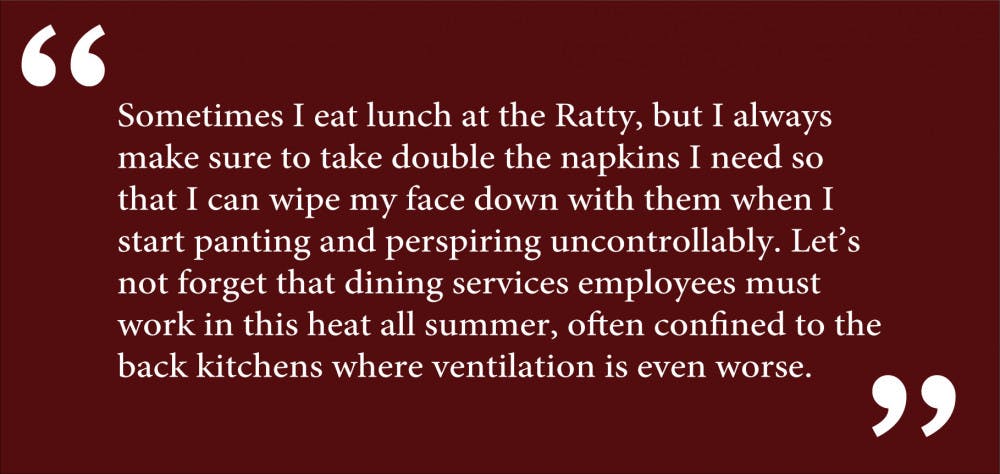Returning to Brown in September is always a bittersweet process for me. Not for the reasons you think: Of course, I hate leaving home and the lack of responsibility that summer affords me. But I also hate returning to Brown because, on campus, I cannot walk anywhere more than two minutes away, especially in September, without drenching myself in sweat. And when I get there, I only sweat more because it’s usually 90 degrees outside and the majority of University buildings do not have air conditioning or adequate ventilation.
Sometimes I eat lunch at the Ratty, but I always make sure to take double the napkins I need so that I can wipe my face down with them when I start panting and perspiring uncontrollably. It’s inevitable, even more so when I sit at a table close to a pizza oven, which raises the temperature in the immediate area 10 or 15 degrees, making the air feel like a furnace. Let’s not forget that dining services employees must work in this heat all summer, often confined to the back kitchens where ventilation is even worse. Occasionally I have to retire myself to the Ratty restroom mid-lunch so I can pat my entire body down with paper towels. It’s unpleasant. This process continues throughout the day unless I happen to be lucky enough to have a lecture in an air-conditioned building like MacMillan or 85 Waterman St.
As someone who was born and raised in Dallas, Texas, I am no stranger to hot weather. The real unfamiliarity is coping with hot weather without any sort of air circulation or ventilation. I realize that this issue is nothing new; in fact it may be one of the University’s oldest problems, and perhaps that is why it has not been addressed for so long. Yet I suspect few students, professors or staff members can honestly say that they have never complained about the lack of air conditioning or cooling in our buildings before. It may seem like a trivial issue compared to many of the other structural issues the University is battling, but given all of the funding going toward construction and renovation, can’t a small percentage of that be spent on some form of cooling system or proper ventilation, at least for central spaces?
Blaming Brown entirely would be a little unfair, as our campus’ lack of central cooling is also a historical problem that stems from air conditioning’s unique and geographic basis in the United States. Air conditioning was invented in 1902 in New York by Willis Carrier, but 63 years later, it was only adopted by 10 percent of U.S. households. Air condition enabled rapid population growth in the Sunbelt cities during the latter half of the 20th century. Millions of air conditioners were sold every year in the 1960s, and this trend only continued in the successive decades. As of 2011, 87 percent of American households own an air conditioner or central air system, according to the Energy Information Administration’s Residential Energy Consumption Survey. But just as these Sun Belt cities have depended on air conditioning for the majority of their history, the United States’ older, eastern cities have always gone without it.
The unfortunate consequence of this history is that a lack of air conditioning in many of New England’s older buildings today is the status quo. It may very well be that much of Brown lacks air conditioning because it’s just plain old. Though approximately 86 percent of new single-family homes in the Northeast are now built with air conditioning, most of Brown’s campus is far from the label “new” and “single-family” (I would actually classify most Brown buildings as “prehistoric” and “multi-family”). And central air conditioning is, as you might have expected, extremely expensive — an AC unit can cost up to $3,400, without factoring in the cost of duct work and the extra energy costs. The cost of implementing this across Brown’s dorms and the Ratty would easily reach into the tens of thousands of dollars, a steep ask from a tight 2017 budget that has only allocated 10.21 percent of its funds to auxiliary operations, down 5 percent from last year’s budget.
There are also valid environmental arguments against implementing central cooling across Brown’s dorms — namely that air-conditioning contributes to intensive energy demand that drives climate change, making the world hotter. Perhaps we don’t need to outfit the entire campus with air conditioning immediately. But I suggest that Brown at least make an attempt to retrofit the Ratty with central air conditioning. Although this is expensive upfront, the change will bring comfort to students, faculty and especially staff members working through the heat. Just because New England has typically lagged behind in installing AC doesn’t mean that we need to take the heat any longer.
Andrew Friedman ’19 can be reached at andrew_friedman@brown.edu. Please send responses to this opinion to letters@browndailyherald.com and other op-eds to opinions@browndailyherald.com.





